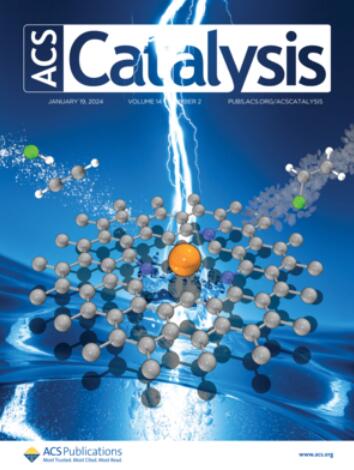Enhancing the Reaction of CO2 and H2O Using Catalysts within a Nonthermal Plasma
IF 11.3
1区 化学
Q1 CHEMISTRY, PHYSICAL
引用次数: 0
Abstract
The direct conversion of emitted and captured carbon dioxide into usable fuels remains a significant challenge and is a key element in the transition to net zero. Herein, we examine the reaction of CO2 and H2O over Ni- and Cu-based catalysts combined with nonthermal plasma (NTP) technology. The catalysis under NTP conditions enabled significantly higher CO2 conversion and product yield, which was almost six times higher than that of the plasma-only system. A maximum H2 concentration of ∼2500 ppm was achieved for the Cu/ZSM5 catalyst at 17% CO2 conversion. Comprehensive catalyst characterization together with the reaction performances reveals that Cu in a reduced state promotes both the CO2 and H2O conversion leading to H2 formation. In situ diffuse reflectance infrared spectroscopy (DRIFTS) coupled with mass spectrometry (MS) analysis of the gas phase products confirms that CO is the major active species to drive the water gas shift reaction to form H2 in addition to the direct CO2 and H2O interaction. It also explains how the different metal support interactions influence the CO adsorption and its interaction with water. Among the catalysts studied, ZSM5-supported Cu catalysts were found to be the most effective in facilitating the CO2 and H2O reaction to produce H2.

求助全文
约1分钟内获得全文
求助全文
来源期刊

ACS Catalysis
CHEMISTRY, PHYSICAL-
CiteScore
20.80
自引率
6.20%
发文量
1253
审稿时长
1.5 months
期刊介绍:
ACS Catalysis is an esteemed journal that publishes original research in the fields of heterogeneous catalysis, molecular catalysis, and biocatalysis. It offers broad coverage across diverse areas such as life sciences, organometallics and synthesis, photochemistry and electrochemistry, drug discovery and synthesis, materials science, environmental protection, polymer discovery and synthesis, and energy and fuels.
The scope of the journal is to showcase innovative work in various aspects of catalysis. This includes new reactions and novel synthetic approaches utilizing known catalysts, the discovery or modification of new catalysts, elucidation of catalytic mechanisms through cutting-edge investigations, practical enhancements of existing processes, as well as conceptual advances in the field. Contributions to ACS Catalysis can encompass both experimental and theoretical research focused on catalytic molecules, macromolecules, and materials that exhibit catalytic turnover.
 求助内容:
求助内容: 应助结果提醒方式:
应助结果提醒方式:


